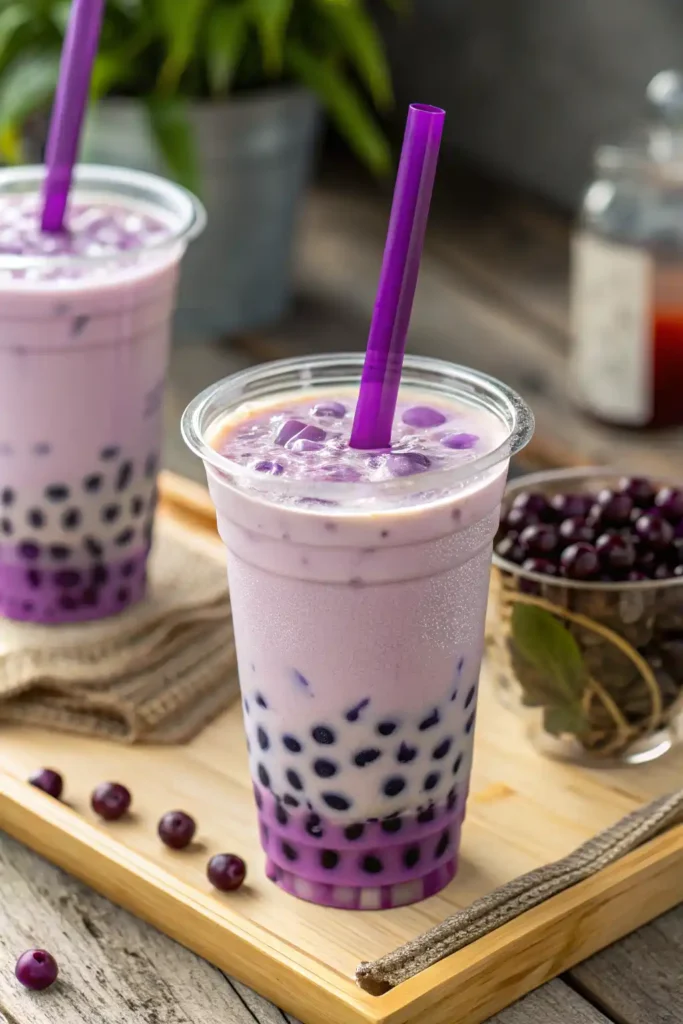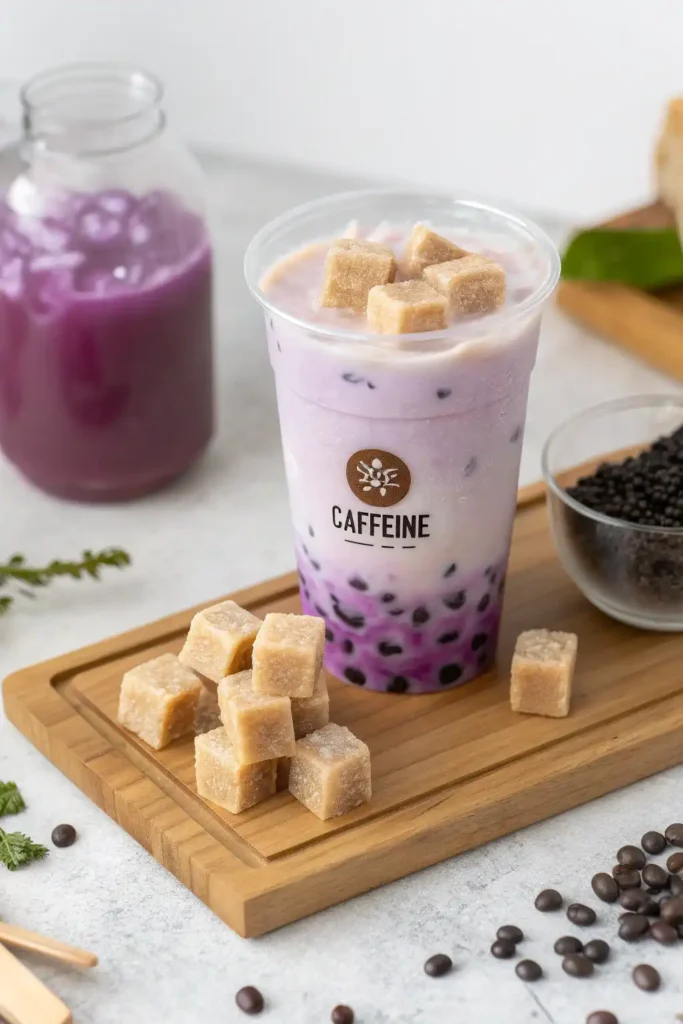Taro milk tea was never just a drink for Clara. At 29, she had tried countless boba flavors, but nothing stirred her senses like the vibrant lavender swirl of taro milk tea. The first time she tasted it was on a breezy spring afternoon in Los Angeles. She had just gotten out of a stressful meeting, looking for something comforting but also different. A small shop with colorful lights and a “try our signature taro milk tea” sign pulled her in. That sip? Earthy, creamy, and just the right amount of sweet. It felt nostalgic and exciting all at once.
That moment sparked a ritual. Now, every Friday, Clara treats herself to a cup of taro milk tea sometimes iced, sometimes hot, and occasionally topped with cheese foam or boba. For her, this purple-hued beverage isn’t just about flavor. It’s about taking a pause, feeling grounded, and savoring a moment of joy. She’s not alone taro milk tea has become one of the most loved flavors in the world of bubble tea, praised for its unique taste and dreamy aesthetic.
But what really is taro milk tea? Is it healthy? Does it contain caffeine? Why does it sometimes taste like sweet potato and is that a good thing? In this deep dive, we’re going to unpack everything from what’s inside a traditional taro bubble tea to how it stacks up against other popular choices like Thai or matcha milk tea.
You’ll also learn how to make taro milk tea at home (yes, even if you’ve never brewed tea in your life), discover tips for customizing your drink with dairy-free options, and find out if this sweet purple wonder is the best choice for boba beginners. Along the way, we’ll answer the internet’s most-asked questions about taro milk tea and even pit it against matcha in a one-on-one flavor face-off.
What Is Taro Milk Tea?
PrintTaro Milk Tea : The Ultimate Guide to Flavor, Health, and Boba Trends
A vibrant purple drink made with tea, taro root powder, milk and usually boba pearls.
- Prep Time: 10mins
- Total Time: 10mins
- Yield: 1 1x
- Cuisine: Asian
Ingredients
- 2 tablespoons taro powder
- ¼ cup tea, strongly brewed
- 1 cup milk
- 1 teaspoon simple syrup (optional)
- ⅓ cup boba pearls
Instructions
-
Cook and Cool the Boba Pearls
Begin by preparing your boba pearls according to the package instructions. Once cooked, drain and allow them to cool completely this ensures they’re the perfect chewy texture for your iced taro milk tea. -
Brew a Strong Tea Base
Steep your preferred tea (black or green works well) until it’s bold and flavorful. Let it cool to room temperature. I recommend brewing it extra strong since you’ll be using a smaller amount in the final drink. -
Make the Taro Milk
In a large cup or mixing mug, combine milk and taro powder. Use a frothing wand to mix until smooth and fully dissolved. Alternatively, whisk by hand or shake in a lidded container for a creamy, lump-free blend. -
Assemble the Drink
Add the cooled boba pearls to a glass, followed by a generous handful of ice. Pour in the cooled tea, then layer the taro milk on top for a beautiful color contrast. -
Taste and Adjust Sweetness
Give the drink a gentle stir and taste. If needed, stir in your preferred sweetener until it reaches your desired level of sweetness.
Notes
- Feel free to experiment with different teas Clara, black, or green tea all bring unique flavors to this recipe.
- This recipe works beautifully with both dairy and non-dairy milk options like oat or soy. (Nutritional info provided is based on dairy milk.)
- Many taro powders come pre-sweetened, so it’s a good idea to check the label or give your taro milk a taste before adding extra sweetener.
- I usually brew hot tea and let it cool before using it in this iced drink, but if you’re preparing a larger batch, cold brewing is a great alternative for a smoother flavor.
- Bubble tea is best enjoyed with a wide straw to accommodate the boba pearls regular straws just won’t cut it!
- You can prepare both the brewed tea and taro milk in advance. Just store them in airtight containers in the fridge they’ll stay fresh for up to three days.
Origin of Taro in Bubble Tea Culture
Taro milk tea originated in Taiwan, the birthplace of bubble tea, which began gaining popularity during the 1980s. Taro, a starchy purple root vegetable widely grown in Asia and the Pacific Islands, quickly became a beloved ingredient in tea shops thanks to its distinct flavor and creamy texture. When mashed and blended with milk and tea, taro created a visually appealing purple drink that tasted as good as it looked. Over the years, taro milk tea has gained a cult following in the U.S., especially among younger boba enthusiasts who crave unique, Instagram-worthy beverages.
From traditional tea houses in Taipei to trendsetting cafés in Los Angeles, taro milk tea has become a symbol of innovation in modern tea culture. Its vibrant color, sweet flavor, and thick consistency have helped it stand out in the crowded world of boba.
What’s Inside a Classic Taro Milk Tea Recipe?
At its core, a classic taro milk tea includes brewed black or green tea, milk (or a dairy-free substitute), sweetener, and taro. Taro can come in two forms: fresh mashed taro or taro powder. The fresh version offers a more earthy, natural flavor, while the powdered version is sweet, smooth, and vividly purple.
Most recipes also include tapioca pearls (boba), but you can find versions with pudding, jelly, or popping boba as well. Sweetened condensed milk is often used for richness, while ice makes it the perfect cooling treat. Every cup of taro milk tea delivers a rich, satisfying taste that’s both comforting and exotic.
What Does Taro Milk Tea Taste Like?

Flavor Profile: Earthy, Sweet, and Creamy Explained
Describing the taste of taro milk tea can be tricky because it’s like nothing else but also oddly familiar. The flavor is mild, subtly sweet, and lightly nutty. When blended with milk, the result is a creamy, smooth drink that feels like a cross between vanilla and coconut with an earthy twist.
Unlike many sugary beverages, taro milk tea has a naturally grounded flavor that balances sweet and savory. It doesn’t overpower the senses, making it a favorite for those who want a milder alternative to overpowering fruit or coffee-based teas.
Does Taro Taste Like Sweet Potato or Vanilla?
Interestingly, many first-timers compare taro’s flavor to sweet potato or even vanilla. That makes sense—both are root vegetables with starchy textures and mild sweetness. But taro milk tea stands apart with its creamy texture and slightly nutty aftertaste.
The use of taro powder often amplifies the vanilla-like notes and gives the drink its signature lavender color. Fresh taro brings a more subtle, earthy tone, so depending on what’s used, the taste can vary slightly. Either way, you’re in for a treat that’s deliciously different.
Is Taro Milk Tea Healthy or Not?
Nutritional Overview: Calories, Sugar, and Fat
Let’s get real taro milk tea isn’t exactly a low-calorie drink. A standard 16 oz serving with whole milk, sweetener, and boba can clock in at 250–400 calories. Most of that comes from added sugars and milk fats. The use of taro powder, which contains artificial flavoring and sugar, can drive up the calorie count even more.
But not all is lost. If you’re watching your intake, many shops now offer sugar-free syrups, low-fat milk options, or lighter versions without toppings. DIY recipes also give you full control over what goes into your cup.
Taro Root Benefits vs. Additives in Boba Shops
Fresh taro root is rich in fiber, antioxidants, and essential vitamins like Vitamin C and E. It supports digestion, heart health, and even skin wellness. Unfortunately, many store-bought versions of taro milk tea use artificial powders that don’t deliver these benefits.
So, while taro root itself is healthy, commercial taro milk tea often isn’t. If you’re craving that purple goodness but want to stay healthy, making it at home with fresh ingredients is your best bet.
Taro Milk Tea vs. Other Milk Teas
Difference Between Regular Milk Tea and Taro Milk Tea
While traditional milk tea is usually made with black tea and milk, taro milk tea swaps in mashed taro or taro powder for a distinct taste and color. Regular milk tea leans toward malty or floral flavors depending on the tea base. In contrast, taro milk tea is earthier and creamier, offering a more dessert-like experience.
Another key difference? Color. Taro milk tea stands out with its eye-catching purple hue, which adds to its popularity among bubble tea fans looking for something visually fun and flavorful.
Taro vs Thai Milk Tea: Taste, Color, and Ingredients
Thai milk tea boasts a bold, spicy flavor profile infused with star anise, cardamom, and robust Ceylon tea, typically balanced with the creamy sweetness of condensed milk. It’s bright orange and intense in flavor. On the other hand, taro milk tea is mellow, lightly nutty, and typically less caffeinated.
If you’re new to boba, taro might feel gentler on the palate, while Thai milk tea is better for those who love stronger, spicier beverages. Both have their fan base, but taro is undoubtedly the more soothing of the two.
Sugar & Caffeine in Taro Milk Tea

Is Taro Milk Tea High in Sugar?
Yes, taro milk tea can be quite high in sugar especially when made with flavored powder or sweetened condensed milk. A typical 16 oz serving might contain up to 40g of sugar, depending on your toppings and sweetness level.
Luckily, many bubble tea shops let you customize your sugar level. Going with 25% or 50% sugar is a great way to cut calories while still enjoying your favorite drink. Making it at home also allows for complete sugar control.
Does Taro Milk Tea Have Caffeine? A Detailed Breakdown
Taro root itself contains no caffeine. However, if your taro milk tea is made with green or black tea as a base, it will have some caffeine usually 30–70mg per serving. But you can always request a non-caffeinated version using milk and taro only.
So, yes, taro milk tea can contain caffeine, but it’s optional. For caffeine-sensitive drinkers, this makes taro an excellent alternative to coffee or energy drinks.
Taro Milk Tea for Beginners
Why Taro Is a Great Boba Choice for Newbies
If you’re just stepping into the world of bubble tea, taro milk tea is a fantastic starting point. Its mild, sweet flavor appeals to a wide audience, and its creamy consistency feels familiar like a milkshake, but better.
Unlike fruit-based teas that can be overly tart or floral, taro offers a balanced, comforting flavor that’s easy to love on the first try. Plus, its unique color makes it one of the most Instagrammed boba drinks of all time.
Best Boba Tea Flavors for First-Timers Compared
While taro milk tea is a crowd favorite, beginners might also enjoy honeydew milk tea, brown sugar milk tea, or classic black milk tea. These flavors are gentle, creamy, and usually lower in acidity than citrus-based teas.
But taro remains a top contender because of its versatility you can customize the sweetness, toppings, and tea base to match your preference. It’s the perfect gateway into the world of boba.
Taro vs Matcha Boba – Which One Wins?
Taste & Texture Showdown: Taro vs Matcha
Taro milk tea is sweet, nutty, and rich, while matcha boba is grassy, slightly bitter, and energizing. Taro drinks lean toward dessert territory, whereas matcha feels more like a superfood elixir.
Texture-wise, both are creamy when made with milk, but taro tends to be smoother, especially when using powder. Matcha can feel a bit gritty if not prepared well.
Health Comparison: Which Is Better for You?
Matcha clearly wins in the nutrition department. It’s high in antioxidants, boosts metabolism, and supports brain function. But that doesn’t mean taro milk tea can’t be healthy it just depends on how it’s made.
Using real taro and limiting sugar makes taro tea a tasty, satisfying treat with some nutritional perks. So it’s all about how you prepare it and what your health goals are.
How to Make Taro Milk Tea at Home

Easy Taro Boba Recipe Using Powder or Fresh Taro
Crafting taro milk tea at home is easier than you might think. If you’re using powder, just mix 2 tablespoons of taro powder with hot water, add brewed tea and milk, then pour over cooked tapioca pearls.
For a fresher take, steam diced taro, mash it, and blend it with milk, sweetener, and tea. It takes a bit more time but gives you a deeper flavor.
Tools, Ingredients, and Step-by-Step InstructionsOptional but fun: boba pearls and a wide straw.
You’ll need a saucepan, blender, tea bags, milk (or substitute), sweetener, and either taro powder or fresh taro. Optional but delightful: chewy boba pearls and a wide straw for the full bubble tea experience.
- Brew tea (black or green) and chill.
- Cook boba pearls and set aside.
- Combine taro powder with hot water, or for a more natural approach, blend cooked taro with milk and sugar until smooth.
- Combine everything over ice and stir well.
Frequently Asked Questions About Taros Milk Tea
What is in a taro milk tea?
Taro milk tea typically contains brewed tea (black or green), milk or a dairy-free alternative, sweetener, and either fresh taro or taro powder. Most versions also include tapioca pearls or other boba toppings for added texture.
What does taro tea taste like?
Taro tea has a mild, creamy, and slightly nutty flavor. It’s often described as a cross between vanilla and sweet potato, especially when made with taro powder.
Is taro milk tea healthy?
It depends on how it’s prepared. Taro root itself is nutritious, rich in fiber and vitamins. However, many commercial versions use sweetened powders that can be high in sugar and calories.
What is the difference between milk tea and taro milk tea?
Regular milk tea usually features black tea and milk, while taro milk tea includes taro as a flavoring. Taro gives the drink a thicker texture, nutty flavor, and a signature purple hue.
Is taro milk tea high in sugar?
Yes, especially when made with sweetened taro powder and boba. You can control the sugar level when ordering or making it at home by adjusting the ingredients.
What does Thai milk tea taste like?
Thai milk tea is bold, spicy, and sweet. It’s made with strong black tea, spices like star anise, and sweetened condensed milk. It’s more intense than taro milk tea in both flavor and color.
Does taro milk tea taste like sweet potato?
Yes, many people think taro tastes like sweet potato with a twist. The flavor is earthier and creamier, especially when combined with milk.
Does taro milk tea have caffeine?
It can, depending on the tea base. If brewed with black or green tea, it contains caffeine. But if made with just milk and taro, it’s caffeine-free.
What is the best boba tea for beginners?
Taro milk tea is an excellent choice for beginners because it’s sweet, creamy, and not too overpowering. Other beginner-friendly options include honeydew, brown sugar, or classic milk tea.
Is taro or Matcha boba better?
That depends on your taste and health goals. Taro is sweet and creamy, while matcha is more grassy and antioxidant-rich. Both are delicious in their own way.
Conclusion
Taro milk tea is more than just a passing trend it’s a beloved global favorite, celebrated for its distinct flavor, smooth creaminess, and signature purple hue. Whether you’re a curious first-timer or a longtime boba fan, this drink delivers comfort, nostalgia, and endless customization.
From understanding its health profile to learning how to make taro milk tea at home, you’ve now got all the info to enjoy this drink in a way that suits your taste and lifestyle.
Learn more about lime juicing tips in our guide: Arizona hard Tea.


